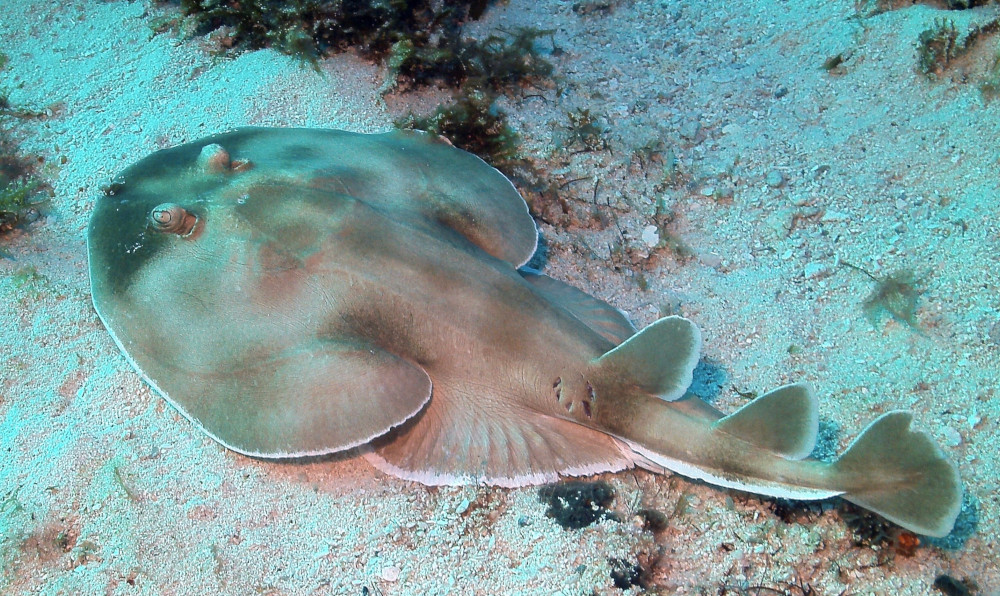Narcine brasiliensis
(Olfers, 1831)
Brazilian electric ray
Classification: Elasmobranchii Torpediniformes Narcinidae
Reference of the original description
Die Gattung Torpedo in ihren naturhistorischen und antiquarischen Beziehungen erläutert. Druckerei der Königlichen Akademie der Wissenschaften Berlin, pp. 35
Die Gattung Torpedo in ihren naturhistorischen und antiquarischen Beziehungen erläutert. Druckerei der Königlichen Akademie der Wissenschaften Berlin, pp. 35
Synonyms / new combinations and misspellings
Narcine brachypleura, Narcine brasiliensis corallina, Narcine brasiliensis punctata, Narcine braunii, Torpedo brasiliensis, Torpedo pictus
Narcine brachypleura, Narcine brasiliensis corallina, Narcine brasiliensis punctata, Narcine braunii, Torpedo brasiliensis, Torpedo pictus
Types
Narcine brasiliensis
Syntype: ZMB: 4577
Narcine brachypleura
Holotype: MNRJ: 548
Narcine brasiliensis corallina
Syntype: MCZ: MCZ 44-S
Narcine brasiliensis punctata
Syntype: MCZ: 752-S
Torpedo pictus
XXXX: No types known;
Narcine brasiliensis
Syntype: ZMB: 4577
Narcine brachypleura
Holotype: MNRJ: 548
Narcine brasiliensis corallina
Syntype: MCZ: MCZ 44-S
Narcine brasiliensis punctata
Syntype: MCZ: 752-S
Torpedo pictus
XXXX: No types known;
Description :
Citation: Narcine brasiliensis (Olfers, 1831): In: Database of modern sharks, rays and chimaeras, www.shark-references.com, World Wide Web electronic publication, Version 01/2026
Please send your images of "Narcine brasiliensis" to info@shark-references.com

Narcine brasiliensis (Olfers, 1831), Cozumel north side. San Juan reef, December 27th, 2019 © Mike Cobb

Narcine brasiliensis (Olfers, 1831), Cozumel north side. San Juan reef, December 27th, 2019 © Mike Cobb
Common names
 Raya eléctrica,
Raya eléctrica,  Tembladera brasilena,
Tembladera brasilena,  Temblador de mar,
Temblador de mar,  Torpedo,
Torpedo,  Torpedo brasileño,
Torpedo brasileño,  Trembladera,
Trembladera,  Raie électrique brésilienne,
Raie électrique brésilienne,  Brazilian electric ray,
Brazilian electric ray,  Bvrazilian electric ray,
Bvrazilian electric ray,  Electric ray,
Electric ray,  Lesser electric ray,
Lesser electric ray,  Small electric ray,
Small electric ray,  Spotted torpedo ray,
Spotted torpedo ray,  Torpedofish,
Torpedofish,  Trembler,
Trembler,  Arraia,
Arraia,  Arraia-elétrica,
Arraia-elétrica,  Emplasto,
Emplasto,  Raia treme treme,
Raia treme treme,  Raia-elétrica,
Raia-elétrica,  Raia-emplasto,
Raia-emplasto,  Treme-treme,
Treme-treme,  Tremelga
Tremelga
 Raya eléctrica,
Raya eléctrica,  Tembladera brasilena,
Tembladera brasilena,  Temblador de mar,
Temblador de mar,  Torpedo,
Torpedo,  Torpedo brasileño,
Torpedo brasileño,  Trembladera,
Trembladera,  Raie électrique brésilienne,
Raie électrique brésilienne,  Brazilian electric ray,
Brazilian electric ray,  Bvrazilian electric ray,
Bvrazilian electric ray,  Electric ray,
Electric ray,  Lesser electric ray,
Lesser electric ray,  Small electric ray,
Small electric ray,  Spotted torpedo ray,
Spotted torpedo ray,  Torpedofish,
Torpedofish,  Trembler,
Trembler,  Arraia,
Arraia,  Arraia-elétrica,
Arraia-elétrica,  Emplasto,
Emplasto,  Raia treme treme,
Raia treme treme,  Raia-elétrica,
Raia-elétrica,  Raia-emplasto,
Raia-emplasto,  Treme-treme,
Treme-treme,  Tremelga
Tremelga
Short Description
A pale sand-colored ray, often with ellipses of dark spots on dorsal side of rounded disk [17659]. Grayish to reddish brown, many rounded blotches outlined with blackish spots. Dark bands across tail up to dorsal fin. Snout darkened [17658].
A pale sand-colored ray, often with ellipses of dark spots on dorsal side of rounded disk [17659]. Grayish to reddish brown, many rounded blotches outlined with blackish spots. Dark bands across tail up to dorsal fin. Snout darkened [17658].
Distribution
Western Atlantic: Espirito Santo, Brazil to northern Argentina (Carvalho, pers. comm.). North Carolina, USA to Florida, northern Gulf of Mexico, central Lesser Antilles and Yucatan [17659]. Source: www.gbif.org
Western Atlantic: Espirito Santo, Brazil to northern Argentina (Carvalho, pers. comm.). North Carolina, USA to Florida, northern Gulf of Mexico, central Lesser Antilles and Yucatan [17659]. Source: www.gbif.org
Human uses
fisheries: subsistence fisheries; aquarium: commercial
fisheries: subsistence fisheries; aquarium: commercial
Biology
Ovoviviparous. Sex ratio of embryos is about one to one, however, small mothers may have predominantly female embryos and that for a given mother, embryos tend to be of one sex (Ref. 46979). Maximum number of embryos per female may reach 15. The young are capable of giving off electric charges even before they are released from the womb (Ref. 46978). Inhabits coastal waters, on sand or mud bottoms [20078]. Common along sandy shorelines, sometimes near coral reefs [1658]. Buries itself with only eyes protruding [1658]. Nocturnal, moves to shallow bays at night to feed; prefers worms, but may take juvenile snake eels, anemones, and, small crustaceans [1658].
Ovoviviparous. Sex ratio of embryos is about one to one, however, small mothers may have predominantly female embryos and that for a given mother, embryos tend to be of one sex (Ref. 46979). Maximum number of embryos per female may reach 15. The young are capable of giving off electric charges even before they are released from the womb (Ref. 46978). Inhabits coastal waters, on sand or mud bottoms [20078]. Common along sandy shorelines, sometimes near coral reefs [1658]. Buries itself with only eyes protruding [1658]. Nocturnal, moves to shallow bays at night to feed; prefers worms, but may take juvenile snake eels, anemones, and, small crustaceans [1658].
Remarks
shark-references Species-ID=4027;
shark-references Species-ID=4027;
Parasites (arranged by Jürgen Pollerspöck)
Cestoda
Hirudinea
Cestoda
- Acanthobothrium electricolum Brooks & Mayes, 1978 [16192] [16356] [25154] [28741]
- Acanthobothrium indicum Subhapradha, 1955 [16423] [28741]
- Acanthobothrium lintoni Goldstein, Henson & Schlicht, 1969 [16318] [16192] [25154] [28741]
Hirudinea

















